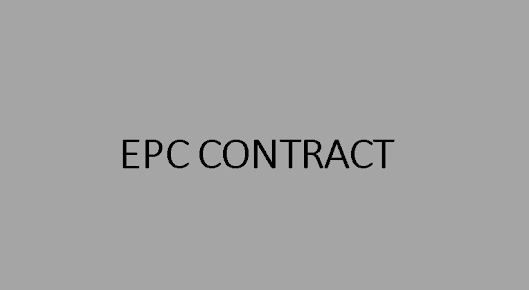The full form of EPC is Engineering, Procurement, and Construction. This contract is a common form of agreement used in the construction and infrastructure industries. It involves a single contractor responsible for the entire project, from design and engineering to procurement and construction. Here are important 40 points on EPC contracts, along with explanations of their advantages and disadvantages:
1. Lump Sum Pricing:
- Advantage: Provides cost certainty for the
project owner.
- Disadvantage: Contractor assumes risks and
may inflate the initial cost estimate.
2. Turnkey Solution:
- Advantage: Project owner has a single point
of contact and responsibility.
- Disadvantage: Limited owner involvement in
the decision-making process.
3. Design-Build Approach:
- Advantage: Faster project completion due to
concurrent design and construction.
- Disadvantage: Limited flexibility for design
changes after construction starts.
4. Risk Allocation:
- Advantage: Clear delineation of risks
between the owner and contractor.
- Disadvantage: Can lead to disputes if risks
are not adequately defined.
5. Single Responsibility:
- Advantage: Simplifies project management for
the owner.
- Disadvantage: May result in a lack of owner
control over individual project phases.
6. Project Management by
Contractor:
- Advantage: Streamlines decision-making and
coordination.
- Disadvantage: Potential conflicts of
interest between cost and quality.
7. Cost Control:
- Advantage: Allows owners to fix costs early
in the project.
- Disadvantage: Contractor may increase
contingency to cover unforeseen risks.
8. Time Efficiency:
- Advantage: Faster project delivery due to
overlapping design and construction.
- Disadvantage: Limited flexibility for
schedule adjustments.
9. Quality Control:
- Advantage: Contractor is responsible for
meeting quality standards.
- Disadvantage: Owner may have limited control
over the quality assurance process.
10. Fixed Timeline:
- Advantage: Provides a clear schedule for
project completion.
- Disadvantage: May lead to shortcuts that
compromise quality.
11. Guaranteed Price:
- Advantage: Owner has cost certainty from the
outset.
- Disadvantage: Contractor may include
contingencies leading to higher costs.
12. Project Financing:
- Advantage: Easier financing as lenders
prefer EPC contracts.
- Disadvantage: Higher financing costs due to
perceived risks.
13. Scope Clarity:
- Advantage: Clearly defines the scope of
work, minimizing scope changes.
- Disadvantage: May not accommodate changes
that arise during construction.
14. Single Point of Contact:
- Advantage: Simplifies communication and
coordination.
- Disadvantage: Limited input from specialized
subcontractors.
15. Performance Guarantees:
- Advantage: Contractor guarantees project
performance criteria.
- Disadvantage: Requires careful definition
and monitoring of performance metrics.
16. Competitive Bidding:
- Advantage: Promotes competition, potentially
reducing costs.
- Disadvantage: Quality may be compromised to
win bids.
17. Early Start on
Construction:
- Advantage: Construction can commence before
detailed design completion.
- Disadvantage: Design changes may cause
delays.
18. Minimal Owner Involvement:
- Advantage: Owner can focus on other aspects
of the business.
- Disadvantage: Limited control and input in
project decisions.
19. Comprehensive Project
Documentation:
- Advantage: Detailed documentation minimizes
misunderstandings.
- Disadvantage: Time and cost associated with
extensive documentation.
20. Change Management:
- Advantage: Formal process for handling
changes.
- Disadvantage: Can lead to disputes if not
managed effectively.
21. Performance Bonds:
- Advantage: Provides financial security for
the owner.
- Disadvantage: Adds to project costs for the
contractor.
22. Subcontractor
Coordination:
- Advantage: Contractor manages all
subcontractors for the owner.
- Disadvantage: Subcontractor issues may
impact the overall project.
23. Warranty Period:
- Advantage: Contractor is responsible for
defects during the warranty period.
- Disadvantage: Potential disputes over what
constitutes a defect.
24. Insurance:
- Advantage: Clear insurance requirements
protect both parties.
- Disadvantage: Premiums may contribute to
overall project costs.
25. Design Responsibility:
- Advantage: Contractor is responsible for
design errors.
- Disadvantage: Design changes may lead to
additional costs and delays.
26. Performance Metrics:
- Advantage: Clearly defined criteria for
successful project completion.
- Disadvantage: Disputes may arise over
interpretation of metrics.
27. Local Regulations
Compliance:
- Advantage: Contractor ensures compliance
with local regulations.
- Disadvantage: Regulatory changes may impact
project costs.
28. Environmental Compliance:
- Advantage: Contractor ensures adherence to
environmental standards.
- Disadvantage: Environmental issues may lead
to delays or added costs.
29. Communication Protocols:
- Advantage: Formalized communication channels
enhance project efficiency.
- Disadvantage: Strict protocols may slow down
decision-making.
30. Payment Terms:
- Advantage: Clear payment milestones provide
financial visibility.
- Disadvantage: Front-loaded payment terms may
affect contractor motivation.
31. Dispute Resolution
Mechanism:
- Advantage: Defines a process for resolving
disputes.
- Disadvantage: Lengthy resolution processes
may hinder project progress.
32. Financial Penalties:
- Advantage: Encourages adherence to project
timelines.
- Disadvantage: May lead to rushed work and
compromise quality.
33. Flexibility for
Innovation:
- Advantage: Contractor may propose innovative
solutions.
- Disadvantage: Innovation may introduce
uncertainties and risks.
34. Owner's Representative:
- Advantage: Provides an owner's
representative for oversight.
- Disadvantage: Adds an additional layer of
management.
35. Technology Transfer:
- Advantage: Allows the transfer of technology
and knowledge.
- Disadvantage: May face resistance from the
contractor.
36. Long-Term Maintenance:
- Advantage: May include provisions for
long-term maintenance.
- Disadvantage: Higher initial costs for
extended services.
37. Currency Fluctuation
Management:
- Advantage: May include mechanisms to manage
currency fluctuations.
- Disadvantage: Complexity and cost associated
with such mechanisms.
38. Performance Reviews:
- Advantage: Regular reviews ensure adherence
to quality and timelines.
- Disadvantage: May strain the contractor-owner
relationship.
39. Social Responsibility:
- Advantage: May include provisions for social
responsibility and community engagement.
- Disadvantage: Additional costs associated
with social initiatives.
40. Exit Strategy:
- Advantage: May include provisions for an
orderly termination of the contract.
- Disadvantage: May lead to legal complexities
and disputes.
It's important to note that the
success of an EPC contract depends on careful drafting, effective
communication, and a thorough understanding of the project's requirements and
risks by both parties involved.


Solid-colour Epoxy Flooring systems are ideal for a range of commercial and industrial settings. They provide an economical, durable, and low-maintenance surface with excellent chemical and stain resistance
ReplyDelete